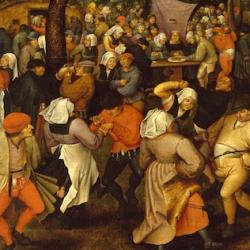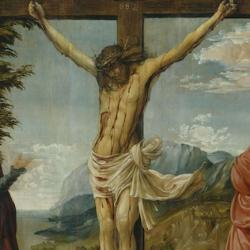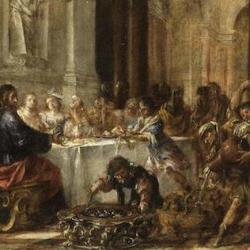John’s use of “dark” and “darkness” is often taken as a symbol of evil, dualistically related to the good that is symbolized by “light.” While his usage does sometimes stretch to this, the fundamental dualism is not moral but temporal. Dark is the period of day before dawn; light is the daytime. Hence, dark is the symbol of the old covenant, while light is symbol of the new.
John uses “dark” or “darkness” nine times in his gospel. The first use (1:5) sets up this meaning. He alludes to the creation account where darkness is not “evil” but simply precedes light. The Word, which is the light of men, shines into the darkness (of Judaism) and the darkness can neither overcome nor comprehend it (John uses a characteristic double entendre). As the gospel unfolds, it’s clear that the “darkness” that neither understands nor overcomes the light is the dark world of Judaism, the nighttime that refuses to give way to the Sun rising.
The treatment of light and dark in Genesis 1 provides important background. In its original form, the creation is dark, formless, empty. God’s first creation is light, which he describes as “good” (1:4). God separates light and darkness, but this separation is not explicitly designated as “good,” as, for instance, the separation of waters on the third day is “good” (1:10). In a general sense, the creation as a whole is “good” (1:31); darkness is never designated as such, nor is the alternation of light and dark explicitly described as good. The reason, I suspect, has to do with eschatology: Just as the second day’s the separation of waters above and below is not called good because that separation is not permanent, so the separation of light and darkness is not good because it will one day yield to permanent, uninterrupted light (Rev 22:5). Genesis is the source of John’s symbolism of light and dark, and, as in Genesis, the symbolism has to do with time and eschatology. When the creation is looked at as a whole, darkness is part of the “good” creation; but it is so only because the darkness gives way to the light. So also, when history is looked at as a whole, the darkness of the Old Covenant are “good,” but they are so only because they are a time of preparation for the coming sunrise.
3:19, Jesus’ nighttime conversation with Nicodemus, is the second use of “darkness” in John’s gospel. The context is conducive to taking “darkness” as a reference to the old covenant. Jesus uses the word “world,” elsewhere clearly used with reference to Judaism (John 15-16). He is the light that has come into this “world.” But the men who are in the dark prefer the darkness and oppose the coming of light. Here Jesus explains why some prefer the darkness of the Old to the Light of the New: “because their deeds were evil . . . lest his deeds should be exposed” (vv. 19-20). The coming of the light does not cover sin but exposes it; the times of ignorance come to an end, and God calls all men everywhere to face judgment. Perhaps too there is some hint that the rites and institutions of the Old Covenant screen people from full exposure to the light: Yahweh is enthroned in light and glory as King and Judge behind a veil; but now the veil is torn, and Yahweh comes through the veil of the firmament to confront us face to face.
Jesus says in 8:12 that “I am the light of the world; he who follows Me shall not walk in the darkness but shall have the light of light.” This comes in the context of a debate with the Jewish leaders, who claim Abraham as father (8:39). Jesus’ use of the same imagery in 12:35, 46 is consistent with this. He comes to judge the world (of Judaism) and to cast out the prince of this world (the devil, cf. 8:44). But those who cling to the light that is Jesus will not be overcome by the darkness of the Jewish world, but will be the true Israel, “sons of light” (12:36). Jesus comes to save His people, the world (v. 47), by coming as the light to bring His people from the darkness of the old world.
The other uses of “dark” in John’s gospel are literal (6:17; 20:1). The disciples set out in a boat; night falls, “and Jesus had not yet come to them.” Finally, in the midst of the night and storm, Jesus walks on the sea and joins them, a mini-exodus scene. Jesus in the storm-tossed boat is the church in the midst of turmoil, and the reference to darkness might add an historical dimension to it: Jesus will bring the disciples through the night of Judaism, which threatens to overturn their little ship, and bring them to the shore. 20:1 tells us that when Mary Magdalene come to the tomb “it was still dark.” No doubt that darkness is the darkness of the night of mourning, the darkness of Mary’s unillumined understanding, and other things; but in the context of John’s gospel as a whole it is also the darkness of the Old Covenant, which is just about to end in the glorious light of the gospel of resurrection.















